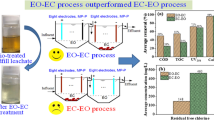Abstract
Two methods were used to remove Cr(VI) from industrial wastewater. Although both are based in the same general reaction: 3Fe(II)(aq) + Cr(VI)(aq) ⇌; 3Fe(III)(aq) + Cr(III)(aq) the way in which the required amount of Fe(II) is added to the wastewater is different for each method. In the chemical method, Fe(II)(aq) is supplied by dissolving FeSO4 · 7(H2O)(s) into the wastewater, while in the electrochemical process Fe(II)(aq) ions are formed directly in solution by anodic dissolution of an steel electrode. After this reduction process, the resulting Cr(III)(aq) and Fe(III)(aq) ions are precipitated as insoluble hydroxide species, in both cases, changing the pH (i.e., adding Ca(OH)2(s)). Based on the chemical and thermodynamic characteristics of the systems Cr(VI)–Cr(III)–H2O–e− and Fe(III)–Fe(II)–H2O–e− both processes were optimized. However we show that the electrochemical option, apart from providing a better form of control, generates significantly less sludge as compared with the chemical process. Furthermore, it is also shown that sludge ageing promotes the formation of soluble polynuclear species of Cr(III). Therefore, it is recommended to separate the chromium and iron-bearing phases once they are formed. We propose the optimum hydraulic conditions for the continuous reduction of Cr(VI) present in the aqueous media treated in a plug-flow reactor.
Similar content being viewed by others

References
M. Stoepler, ‘Hazardous Metals in the Environment Techniques and Instrumentation in Analytical Chemistry’ (Elsevier, New York, 1992), p. 373.
J. Gaulhofer and V. Biabchi, ‘Chromium. Metals and their Compounds in the Environment’ (VCH, Wheinheim, 1991), p. 30.
R. Cespón-Romero, M. Yebra-Biurrum and M. Bernejo-Barrera, Anal. Chim. Acta 327 (1996) 37.
J. Nriagu and E. Nieboer, ‘Chromium in the Natural and Human Environments’ (Wiley Series, New York, 1988), p. 82.
D. Golub and Y. Oren, J. Appl. Electrochem. 19 (1989) 311.
S. Goeringer, N.R. Tacconi, C.R. Chenthamarakshan C.R. and K. Rajeshwar, J. Appl. Electrochem. 30 (2000) 891.
S.E. Jardine, M.A. Fendorf, Mayes, L. Larsen, S. Brooks and W. Bailey, Environ. Sci. Technol. 33 (1999) 2939.
F. Colín and S. Gazbar, Wat. Res. 29 (1995) 2000.
S.A. Martínez, M.G. Rodrìguez and C. Barrera, Wat. Sci. Technol. 231 (2000) 65.
J.H. Glynn and G.W. Heinke, ‘Environmental Engineering’ (Pearson, México, 1999), chapter 12.
APHA, AWWA, ‘Standard Methods for the Examination of Water and Wastewater’, 19th edn (American Public Health Association, Washington DC, 1995).
A. Serruya, B.R. Scharifker, I. González, M.T. Oropeza and M. Palomar-Pardavé, J. Appl. Eletrochem. 26 (1996) 451.
M. Palomar-Pardavé, M.T. Ramírez, I. González, A. Serruya and B.R. Scharifker, J. Electrochem. Soc. 143 (1996) 1539.
A.B. Soto, E.M. Arce, M. Palomar-Pardavé and I. Gonza´ lez, Electrochim. Acta 41 (1996) 2647.
M. Palomar-Pardavé, I. González, A.B. Soto and E.M. Arce, J. Electroanal. Chem. 443 (1998) 125.
A. Rojas-Hernández, M.T. Ramírez, J.G. Ibáñez and I. González, J. Electrochem Soc. 138 (1991) 365.
A. Rojas-Hernández, M.T. Ramírez and I. Gonza´ lez, J. Chem. Ed. 72 (1995) 1099.
C. Baes and R. Mesmer, ‘The Hydrolysis of Cations’, 2nd edn (Robert E. Krieger, Publising, Malabar, FA 1986), p. 211.
W. Stumm and J. Morgan, ‘Aquatic Chemistry: Chemical Equilibria and Rates in Natural Waters’, 3rd edn (John Wiley & Sons, New York, 1996), p. 234.
I.J. Buerge and S.J. Stephan, Environ. Sci. Technol. 33 (1999) 4285.
R.R. Patterson, S. Fendorf and M. Fendorf, Environ. Sci. Technol. 31 (1997) 2039.
N. Kongsricharoern and C. Polprasert, Water Sci. Tech. 31 (1995) 109.
E.M.N. Chirwa and Y. Wang, Environ. Sci. Technol. 31 (1997) 1446.
J. Bard and L.R. Faulker, ‘Electrochemical Methods’ (John Wiley & Sons, New York, 1985), p. 324.
A. Rojas Hernández, M.T. Ramírez and I. González, Anal. Chim. Acta 278 (1993) 321.
A. Rojas Hernández, M.T. Ramírez and I. González, Anal. Chim. Acta 278 (1993) 335.
Code of Federal Regulations, Chapter I, Title 40 section 141.11 (2002).
SEMARNAP, NOM-001-ECOL-1996, Diario Oficial de la Federación, México (1996).
M.J. Avena, C.E. Giacomelli, C.D. García and C.P. De Pauli, Langmuir 12 (1996) 6659.
J.P. Fitts, G.E. Brown and G.A. Parks, Environ. Sci. Technol. 34 (2000) 5122.
X. Chen, G. Chen and P.L. Yue, Environ. Sci. Technol. 36 (2002) 778.
US EPA, Office of Solid Waste. ‘Regulatory Impact Analysis of the Final Rule for 180-day Accumulation Time for F006 Wastewater Treatment Sludges’. Prepared by DPRA Inc., St. Paul, (14 Jan. 2000), p. 21.
US EPA, Office of Solid Waste. ‘Background Documents for the Cost and Economic Impact Analysis of Listing Four Petroleum refining Wastes as Hazardous Waste under RCRA Subtitle C’. Prepared by DPRA Inc., (Jan. 1998), pp. 3–6.
Author information
Authors and Affiliations
Corresponding author
Rights and permissions
About this article
Cite this article
Barrera-Díaz, C., Palomar-Pardavé, M., Romero-Romo, M. et al. Chemical and electrochemical considerations on the removal process of hexavalent chromium from aqueous media. Journal of Applied Electrochemistry 33, 61–71 (2003). https://doi.org/10.1023/A:1022983919644
Issue Date:
DOI: https://doi.org/10.1023/A:1022983919644



